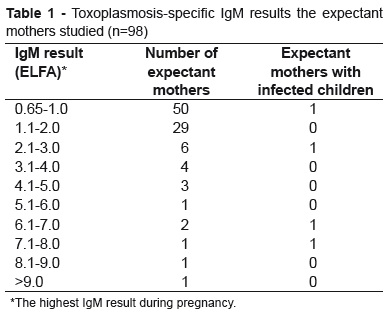OBJECTIVE: To analyze the diagnostic and therapeutic approach of pregnant women with positive IgM test for toxoplasmosis and the follow-up of their children in a public hospital of Rio de Janeiro, Brazil. METHODS: This cross-sectional retrospective study from 2003 to 2006 enrolled 98 pregnant women with positive IgM test for toxoplasmosis and 99 children. The follow-up of the children with or without congenital infection was reviewed, as well as the clinical presentation of those with congenital infection and the laboratory tests used to diagnose the infection by Toxoplasma gondii during pregnancy. RESULTS: Toxoplasmosis was diagnosed in the second and third trimesters of pregnancy in 76 patients. In 36 pregnant women, determination of the serum levels of IgM was the only laboratory method used to diagnose the infection. Low IgM levels analyzed by ELFA were detected in 49 pregnant women. IgG avidity test was performed in 62 patients and in 13% of them the exam was carried out during the first trimester of pregnancy. Specific treatment for toxoplasmosis was applied in 93 women. Vertical transmission rate was 4%. Clinical manifestation of congenital toxoplasmosis was found in all infected children. All non-infected children showed a decrease in IgG serum levels for toxoplasmosis during the follow-up. The mean age for negativation of IgG serum levels in these children was 5.4 months. CONCLUSIONS: Our results suggest that the use of a positive IgM test to toxoplasmosis as the only antibody marker to detect recent infection has a limited value.
toxoplasmosis; prenatal diagnosis; toxoplasmosis, congenital; infant, newborn




